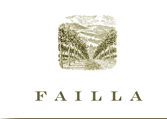|
|

theCompass mobile application is a winery, brewery, and distillery locator for North America. |
|
|
Failla Wines

|
|
While the history of Failla (pronounced FAY-la) is short it is not without its complexities. Founded as Failla Jordan in 1998, it took its name from the husband-and-wife team of winemaker Ehren Jordan and fellow debtor Anne-Marie Failla. That year we planted our Estate vineyard on the Sonoma Coast and began buying fruit for our first releases, the very Rhône-style ‘98 Alban Vineyard Viognier and ‘98 Que Syrah Syrah. John Alban’s vineyards are located in the Edna Valley near San Luis Obispo on the Central Coast and Al & Virginia Rago’s Que Syrah vineyard is in Occidental on the Sonoma Coast. Pinot Noir from Marcy Keefer’s ranch in the Russian River Valley joined the team this year with the 2000 vintage. However, after three vintages under the Failla Jordan label, the must hit the fan and we got into a legal dust-up with Jordan Vineyards and Winery. When the smoke cleared, we had agreed to cease using Ehren’s last name to avoid trampling tender trademark toes and, putting our best foot (and better half) forward, we are continuing with simply "Failla". Many folks have asked us why we didn’t just pick a fanciful name in the first place instead of playing roulette with our own surnames. Well, we never found ruins of missions, limestone kilns, stone walls or barns on our property, just several old trailers. Existing plants on the ranch include such wine-incompatible flora as agave (shot of tequila anyone?) and bay trees (boiled crabs anyone?). And geographic features on our local topo maps sport monikers such as Brain Ridge, Gualala River, and Hell Hole.
|
|
|
Directions
View Map
|
View Weather
Edna Valley Viognier, Alban Vineyard
Picked in early- September, the fruit was whole-cluster pressed into neutral French oak barrels and allowed to ferment on native yeast alone at a languorous 8-month pace. After malolactic took its time, the wine was bottled unfiltered the following September. Penetrating floral aromas of orange blossom and honeysuckle are interspersed with lychee nuts and fresh mown hay. This Viognier exhibits crisp acidity balanced with a surprising sweetness in the finish.
|
Napa Valley Syrah, Phoenix Ranch
The 2004 Phoenix Syrah, picked in early September, was split into one tank of fully destemmed fruit and a second tank including 70% whole clusters to introduce the classic Rhône element of peppery aromatics. After fermentation, the wine was barreled-down into French oak, 1/3 new. With aromas of roasting meat, violets and black pepper, this full-bodied Syrah offers rustic tannins that will reward cellaring of 8-12 months. Should age well for 7-10 years.
|
Russian River Valley Chardonnay, Keefer Ranch
Ripe by mid-September, the fruit was whole-cluster pressed into French oak barrels, one-third of which were new. Ehren relies on native yeast alone to slowly ferment this cool-climate Chardonnay allowing complex flavors to develop and integrate. Over 10 months, a fruity, yet vaguely floral, nose of apple and pear emerged, while Chablis-like minerality highlights the delicate entry with well-balanced acidity. This Chardonnay completed malolactic fermentation for considerable depth and broadness on the palate and a smooth and persistent finish.
|
Russian River Valley Pinot Noir, Keefer Ranch
Picked in early September, the fruit was destemmed into open-topped fermenters and treated to twice daily manual punch downs during fermentation. After aging for 12 months in French oak barrels, 1/3 of which were new, the wine was bottled unfiltered in September, 2005. The classic Burgundian aromas of black cherry and baking spices are joined by an intense nose of roses. The lush mouth feel and mid-palette sweetness testify to the rich, round food-friendly tannins. Decant to drink now or lay down for up to a year; this wine will age well for 5-7 years
|
Sonoma Coast Pinot Noir, Hirsch Vineyard
We picked this fruit in two passes about a week apart in late September, first the Pommard clone then the Mt. Eden. As always, we destemmed the fruit into open-topped fermenters where it was handled gently with daily manual punch-downs. We then aged the wine in all French oak barrels, one-third of which were new. The "pure-Pinot nose" marked by nuances of tea, cinnamon and classic notes of light and dark cherry, is so intense you may forget to actually drink it. If you do continue on you will be rewarded with great subtlety and delicacy on the palate and a bit of cola on the finish. Although this wine should cellar well for 5-7 years, Ehren says it is "Oh so tasty, now".
|
Sonoma Coast Syrah, Estate Vineyard
After the fruit was picked in early October, one-third was added to open-topped vessels as whole clusters and the rest destemmed, then treated to daily punch-downs throughout fermentation before aging in 60% new French oak. The 2003 Estate Syrah exhibits a classic Côte-Rôtie nose filled with black pepper, bacon fat and hints of violet and dark berries. A peppery entry transforms into a fruity mid-palate followed by a robust finish that lingers. You’ll find surprising balance and structure from these relatively young vines. Decant if you wish to enjoy it immediately, but this wine will age beautifully for 10-12 years.
|
Add New Review
|
|